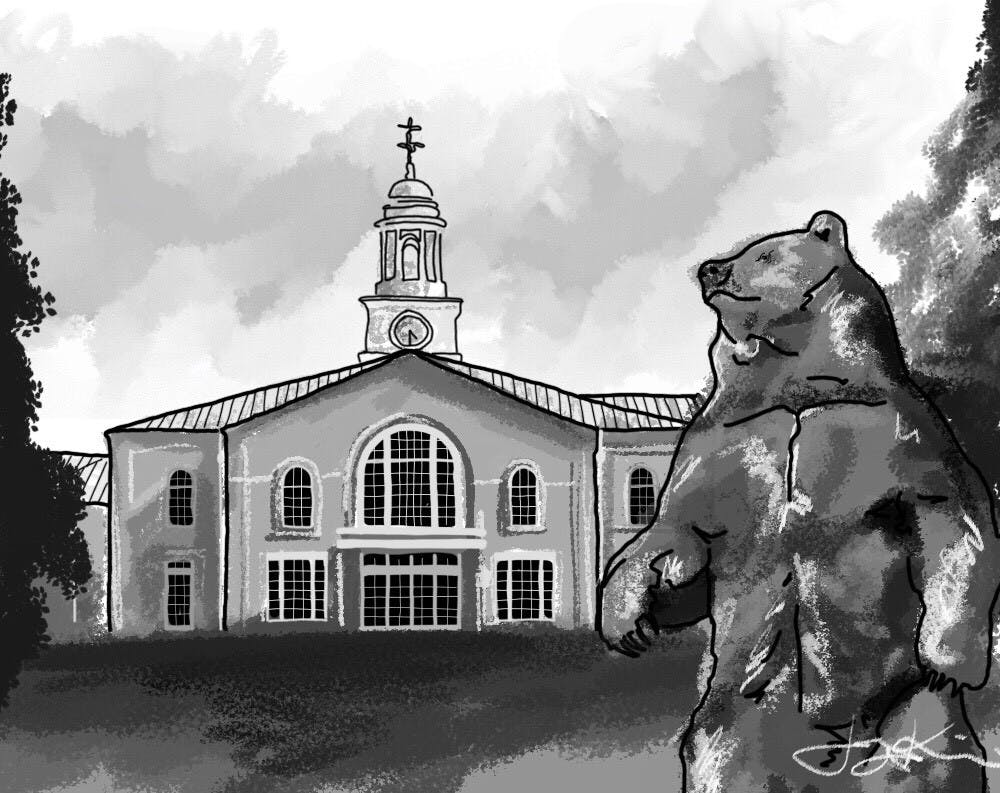I don’t play basketball. It’s nothing against the sport itself, but I never grew up playing it. While I like to think it was just chance that led me to sign up for other sports during my childhood, I reluctantly admit that even in middle school, I recognized that I lacked the — ahem — vertical prerequisites for success in basketball. From time to time, though, (as we all do) I find myself talking about things that don’t particularly interest me. And indeed, during the beginning of the semester, I found myself talking to a friend who worked at the front desk of the Olney-Margolies Athletic Center about what I thought would be the most boring, most anodyne job on campus — essentially serving as a gatekeeper to the recreational basketball courts. So I innocently asked them how they liked the job, expecting them to tell me it was, in fact, the most boring, most anodyne job on campus. That isn’t quite how they responded, though. They told me they disliked their job. They said they didn’t like how they were required almost daily to turn away local high school students looking to play basketball.
The University is transparent about its policy toward members of the Providence community using its athletic facilities. It notes on its website that guests — that is, non-Brown or RISD students, faculty or staff — must pay a daily $10 fee to use its facilities, like the basketball courts in the OMAC. But that there is actually demand from other members of the Providence community for access to these facilities was, at least to me, less obvious. Trivial as this might seem, it is through small interactions like these that Brown establishes its reputation in the community. And while it goes without saying that Brown is most interested in serving the needs and wants of its own students, faculty and staff, that does not mean it has no obligations to the community, and it certainly does not justify adopting an arbitrarily exclusive policy. Opening the OMAC and other athletic facilities, even if it’s only for publicized, fixed “open hours” a few times a week, is a small but important gesture that would not only provide young people in Providence a valuable service, but also help to cultivate a stronger sense that Brown is more than just an ivory tower that exclusively serves its own interests.
Of course, in conversations I’ve had with friends about this topic, I’ve heard objections. Primarily, I’ve been told that the University should care for members of its own community first, and that by opening up athletic facilities to the public, we’re diluting the quality of the services students pay for (through overcrowding, increasing the likelihood of damage to facilities, etc.). I’m not sympathetic to this argument for several reasons. First, while Brown should prioritize the needs of its students, it still carries a responsibility to support members of the Providence community. Their argument becomes particularly facile when one considers that Brown pays nothing in taxes to the city, despite owning approximately 150 tax-exempt buildings with a combined valuation of over $1 billion. Though the University does provide the city with payment in lieu of taxes, these payments are a fraction of what it would otherwise pay to the city. It is unreasonable, and borders on abject greed, to completely dismiss the notion that Brown has responsibilities beyond its own students, faculty and staff when one considers how we continue to benefit from the city’s good will.
It’s also uncompelling to assert that limited public access to athletic facilities would somehow take away from the quality of our experience. First, and perhaps most importantly, the current policy does not prohibit public access altogether — members of the community are still eligible to use athletic facilities even now, if they pay. The argument that public access somehow takes away from the experiences of members of the Brown community seems more like a pretext for exclusion rather than a legitimate justification for dismissing free public access. Though it’s true that eliminating the $10 fee during potential open hours would increase the amount of public demand for Brown’s athletic facilities during these times, it strains credulity to hold that this new increased usage would substantially detract from the experience of Brown community members. Mid-afternoon open hours on weekdays — the time local students would be most likely to use these facilities — hardly strikes me as a popular time for Brown students, faculty and staff to play basketball or run laps around the indoor track.
While this argument might seem frivolous, it highlights one of many small, effortless gestures the University can make to demonstrate that it is serious in its commitment to contribute meaningfully to the Providence community. The current policy toward public access to athletic facilities is prohibitively expensive for certain members of the community like high school students — and pointlessly so. By creating free open hours at its athletic facilities several times a week, Brown could, with minimal effort, take a meaningful step toward cultivating its role as a member of the Providence community.
Connor Cardoso ’19 can be reached at connor_cardoso@brown.edu. Please send responses to this opinion to letters@browndailyherald.com and op-eds to opinions@browndailyherald.com.





